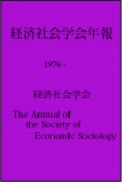Volume 39
Displaying 1-18 of 18 articles from this issue
- |<
- <
- 1
- >
- >|
Invited Lecture
-
2017Volume 39 Pages 5-13
Published: 2017
Released on J-STAGE: April 01, 2021
Download PDF (1409K)
Symposium: New Horizon of Publicness
-
2017Volume 39 Pages 14-23
Published: 2017
Released on J-STAGE: April 01, 2021
Download PDF (1501K) -
2017Volume 39 Pages 27-35
Published: 2017
Released on J-STAGE: April 01, 2021
Download PDF (1698K) -
2017Volume 39 Pages 39-48
Published: 2017
Released on J-STAGE: April 01, 2021
Download PDF (1329K)
Free Subject Articles (Refereed)
-
2017Volume 39 Pages 60-68
Published: 2017
Released on J-STAGE: April 01, 2021
Download PDF (1980K) -
2017Volume 39 Pages 69-80
Published: 2017
Released on J-STAGE: April 01, 2021
Download PDF (1845K) -
2017Volume 39 Pages 81-91
Published: 2017
Released on J-STAGE: April 01, 2021
Download PDF (1607K) -
2017Volume 39 Pages 92-100
Published: 2017
Released on J-STAGE: April 01, 2021
Download PDF (1583K) -
2017Volume 39 Pages 101-111
Published: 2017
Released on J-STAGE: April 01, 2021
Download PDF (1598K) -
2017Volume 39 Pages 112-122
Published: 2017
Released on J-STAGE: April 01, 2021
Download PDF (1750K) -
2017Volume 39 Pages 123-138
Published: 2017
Released on J-STAGE: April 01, 2021
Download PDF (2390K)
Contributory Papers (Refereed)
-
2017Volume 39 Pages 187-200
Published: 2017
Released on J-STAGE: April 01, 2021
Download PDF (1425K)
Book Reviews
-
2017Volume 39 Pages 201-202
Published: 2017
Released on J-STAGE: April 01, 2021
Download PDF (1164K) -
2017Volume 39 Pages 203-204
Published: 2017
Released on J-STAGE: April 01, 2021
Download PDF (1198K) -
2017Volume 39 Pages 205-207
Published: 2017
Released on J-STAGE: April 01, 2021
Download PDF (1165K) -
2017Volume 39 Pages 208-209
Published: 2017
Released on J-STAGE: April 01, 2021
Download PDF (1164K) -
2017Volume 39 Pages 210-211
Published: 2017
Released on J-STAGE: April 01, 2021
Download PDF (1164K) -
2017Volume 39 Pages 212-215
Published: 2017
Released on J-STAGE: April 01, 2021
Download PDF (1218K)
- |<
- <
- 1
- >
- >|
